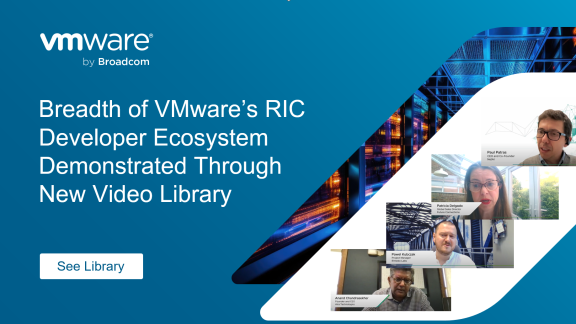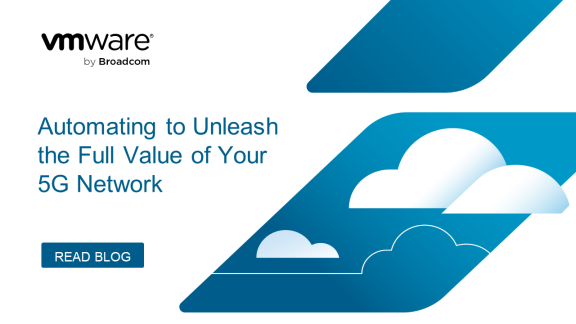When you think about the future of sustainability, which technologies first come to mind? Ask most people, and they’ll say electric vehicles or solar panels or wind farms. Increasingly though, we need to put another technology at the top of the list: telecommunications networks.
Leading communications service providers (CSPs) are increasingly working at the cutting-edge of environmental sustainability. And it’s a good thing too—Information and Communications Technology (ICT) currently accounts for up to 10% of the world’s energy usage. With denser and more sophisticated 5G networks on the horizon, telecom networks could become an even bigger source of energy consumption and carbon emissions. Fortunately, the world’s leading CSPs are taking steps to improve efficiency and reduce emissions across their networks. And VMware is playing a major role in helping them do MORE with LESS.
A recent scientific paper authored by VMware researchers and engineers lays out the four key pillars of a zero-carbon ICT strategy:
- Reducing greenhouse emissions
- Improving energy efficiency
- Shifting to renewables
- Breaking down institutional barriers to sustainable operations
VMware is working across all these pillars to help our CSP customers build more sustainable networks and businesses. Together, we’re making major strides towards a zero-carbon future.

The Zero-Carbon ICT Challenge
The world’s telecom networks and data centers do amazing things for modern businesses and consumers. But historically, they’ve also played a large (and growing) role in energy consumption and greenhouse emissions. Data centers in particular burn through vast amounts of electricity—collectively generating as much CO2 as the airline industry, according to one 2018 study. And the problem is growing, with another study projecting ICT could account for up to 20% of global emissions by 2030.
One big driver for this spike: 5G. GSMA estimates that the potential 1,000x increase in data traffic, along with the new infrastructure that comes with 5G, could as much as triple the industry’s overall energy consumption. 451 Research projects that 5G will increase total network energy consumption by up to 170% by 2026, with the largest increases in macro-node and network data centers.
These forecasts pose a stiff challenge for CSPs and the ICT ecosystem supporting them. But they also hold tremendous opportunity. If we can make even small changes to CSP networks and operating models, those efforts can add up to major progress towards the industry’s zero-carbon goals.
VMware Leads the Way
VMware is in an excellent position to help advance these zero-carbon efforts, and we’re taking advantage of it. Our commitment to environmental sustainability isn’t new. VMware is a certified carbon-neutral company, powered 100% by renewable energy. And over the years, we’ve played a major role in reducing greenhouse emissions, both internally and for our customers.
An early pioneer and leader in virtualization, VMware built its success on helping organizations grow their business while using less ICT hardware, reducing energy consumption and waste. According to IDC, VMware virtualization innovations from 2003 to 2019 have resulted in:
- Organizations worldwide deploying more than 142 million fewer physical servers
- Cumulative energy savings of nearly more than 1.5 billion megawatt hours (MWh) from IT infrastructure avoidance
- Total avoidance of 1.2 billion metric tons of CO2 emissions (In 2019 alone, emissions avoided from VMware virtualization equated to removing nearly 33 million cars from the road.)
And virtualization is just one part of VMware’s commitment to sustainability.
Reducing Greenhouse Emissions
As networks and data centers have grown in recent years, ICT infrastructure now represents a significant portion of the world’s total carbon emission—and a huge opportunity for zero-carbon innovation. Beyond the benefits of virtualization, noted above, VMware is helping CSPs and enterprises reduce emissions through multiple initiatives:
- CSP automation: As CSPs adopt Telco Cloud architectures, their operations can get far more complex. VMware Telco Cloud Automation (TCA) can simplify the process of packing virtualized and containerized network functions (VNFs/CNFs) onto servers, reducing the time it takes to deploy cell sites by as much as 80%. This helps operators reduce truck-rolls to expand 5G rollouts and make updates while reducing emissions related to deploying and testing 5G equipment.
- Emissions tracking: We’re building new tools to help CSPs measure carbon emissions in computing infrastructure. VMware Aria Operations, for example, features the industry’s first sustainability dashboards to help businesses identify idle workloads and optimize their carbon footprint. Organizations can use these tools to measure electricity consumption and track carbon footprint in their data centers.
Improving Energy Efficiency and Shifting to Renewables
The biggest opportunity for CSPs to advance zero-carbon initiatives involves reducing energy consumption, especially in Radio Access Networks (RAN). According to one study, the RAN accounts for more than half of all energy used in CSP networks. VMware is developing several smart power innovations to help address this, including:
- Hypervisor management tools that reduce emissions and energy consumption by powering down portions of the RAN when not in use
- A traffic-based power management RAN Intelligent Controller (RIC) application that manages power across cell sites based on real-time traffic load
- Deep cooling technology that uses Artificial Intelligence (AI) to model power load, heating, and cooling in large data centers, and automatically adjust system parameters to optimize power (read blog)
- A spectrum multiplier RIC application from Cohere paired with the VMware RIC helps CSPs deliver up to 2x the spectral capacity using about the same energy
VMware is also helping CSPs and enterprises shift more of their operations to renewable power sources with innovations like:
- Carbon-aware workload placement: We’re developing a new solution, demonstrated at Mobile World Congress 2022, that tracks carbon density data from the power grid to make smarter workload placement decisions—potentially reducing RAN emissions by up to 52%.
- Workload shifting: Sincerenewable sources like wind and solar aren’t always available in every location, VMware is developing tools to help CSPs move workloads to data centers powered by renewables whenever possible.
Overcoming Institutional Barriers
Often, the biggest barriers to a zero-carbon future aren’t about technology. They stem from social factors: culture, policy, processes, and just resistance to change. VMware is working closely with CSPs and other industry leaders to break down these barriers to a more sustainable future.
To help communicate opportunities clearly within CSP organizations, VMware works with our customers to create demos which make the economic, performance, and sustainability cases for your transformation projects. Once the discussion is started, VMware hosts working sessions to help your broader organization participate in sustainability conversations with our team of experts. Between flexible commercial models and training for VMware green tools (noted above, Aria, Telco Cloud Operations, etc.), our team helps to create the information and experiences you’ll need to overcome barriers.
VMware technologists play leadership roles in many of the industry groups shaping zero-carbon ICT initiatives. Examples include the Next Generation of Sustainable Digital Infrastructure (based on a partnership between VMware and the National Science Foundation), the Green Software Foundation (GSF), the Green G Working Group within the Next G Alliance, and many others. Through efforts like these, we’re helping to develop best practices, tools, and standards to enable more sustainable ICT software, hardware, and processes.
And because enterprises around the world have similar sustainability goals as you, we urge you to join the VMware Zero Carbon Committed Initiative. VMware Zero Carbon Committed providers have set goals to power their data centers and networks with 100% renewable energy or achieve carbon neutrality in or before 2030. These providers are also VMware Cloud Verified – using the full VMware Cloud infrastructure to provide unparalleled cloud services to their customers. The goal is to make it easy for enterprise customers to find a service provider that can help them achieve their own sustainability/net zero goals.
Building Tomorrow’s Sustainable Networks
CSPs and their vendors have a big task ahead to achieve zero-carbon ICT. Fortunately, visionary leaders across the industry are hard at work to make this vision a reality. VMware is pleased to be playing a key role in this effort.
The examples cited here represent just one small part of VMware’s sustainability story. For more details about the many projects we’re working on, download the white paper “How VMware Helps Create Tomorrow’s Sustainable Telco Networks”.
Ready to get started. Read our blog about places to start.









